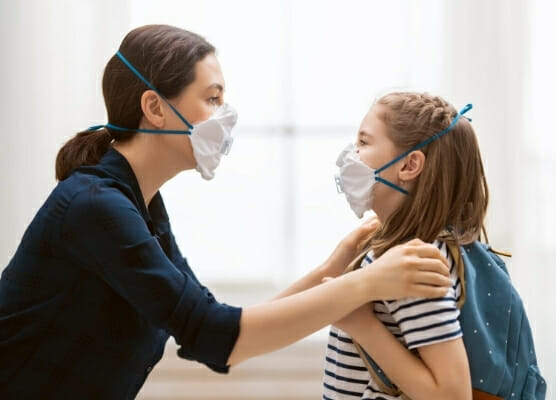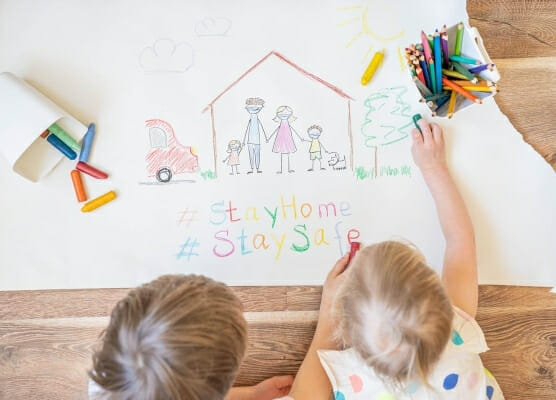FFCRA leave run out? Workers may be entitled to more anyway
 The Families First Coronavirus Response Act (FFCRA) requires paid leave for most employees impacted by the COVID-19 pandemic. Quarantine, testing, treatment, caring for family are all covered. So is caring for children whose schools have closed for COVID-19 related reasons. Congress passed the FFCRA back in spring as the pandemic was accelerating. Perhaps assuming cases would fall quickly, lawmakers set an end date of December 31, 2020, when the law sunsets. The assumption was that most workers would need just 2 weeks off to quarantine, test and recover if stricken ill. That time would be paid under the Emergency Paid Sick Leave Act (EPSLA). Schools weren’t expected to remain shuttered longer than the time off the Emergency Family and Medical Leave Act (EFMLA) provides.
The Families First Coronavirus Response Act (FFCRA) requires paid leave for most employees impacted by the COVID-19 pandemic. Quarantine, testing, treatment, caring for family are all covered. So is caring for children whose schools have closed for COVID-19 related reasons. Congress passed the FFCRA back in spring as the pandemic was accelerating. Perhaps assuming cases would fall quickly, lawmakers set an end date of December 31, 2020, when the law sunsets. The assumption was that most workers would need just 2 weeks off to quarantine, test and recover if stricken ill. That time would be paid under the Emergency Paid Sick Leave Act (EPSLA). Schools weren’t expected to remain shuttered longer than the time off the Emergency Family and Medical Leave Act (EFMLA) provides.
But the pandemic continues to upend life and work. For example, some areas had few infections early on. Now, the virus has spread to regions previously little affected. Employees whose children’s schools remained open before but now can’t reopen may now need paid leave under the FFCRA. Others may have used their entitlement but still find themselves caring for children whose daycare centers have reduced capacity. Quite a few childcare operators are prioritizing children of essential workers like doctors. That leaves teleworking parents with few options.
Employers need a plan to manage both kinds of FFCRA leave. They also have to figure out what leave employees may be entitled to and for which reasons. Assuming that once an employee has used up FFCRA there’s no more time off available can be a big mistake.
FFCRA basics
There are two major reasons for paid leave under the FFCRA’s EPSLA and EFMLA. The first is diagnosis, illness and care for employees and their family members who have been exposed to or have COVID-19. The second is for employees who cannot work because their children’s childcare or schools are closed due to the pandemic. The EPSLA provides 80 hours off at either full or partial pay for both reasons though at differing rates. The EFMLA extends partially paid time off for an additional 10 weeks for childcare and school closings only. Together, FFCRA provides and pays as follows:
- Up to two weeks (80 hours, or a part-time employee’s two-week equivalent) of paid sick leave based on the higher of their regular rate of pay, or the applicable state or Federal minimum wage;
- 100% if the employee has been ordered quarantined by authorities, told to quarantine by a medical provider or is seeking diagnosis and treatment for symptoms of COVID-19, up to $511 daily and $5,110 total;
- 2/3 pay to care for a family member quarantined or ill with COVID-19, up to $200 daily and $2,000 total; and
- Up to 12 weeks of paid sick leave and expanded family and medical leave combined paid at 2/3 for school and childcare closures for up to $200 daily and $12,000 total.
FFCRA notices, poster and certification forms
The DOL issued emergency regulations shortly after the FFCRA passed. It also created a poster summarizing employee rights and employer responsibilities. Employers must:
- Inform employees about their right to take one or both forms of paid leave. Employers should update their benefits information to add FFCRA leave to other leave policies. Include the update in your employee handbook, too.
- Post the new DOL FFCRA rights poster where they post other requires federal, state and local rights posters. You can download the FFCRA poster from the DOL webpage and can also include it in your handbook. Download here.
- Create FFCRA leave certification forms based on the DOL emergency regulations. Employers may also ask for supporting documentation. DOL suggests employers exercise discretion and allow various document sources. For example, DOL suggests that a school website closure notice should suffice to show a COVID-related school closure. The form must ask for the following information:
- The employee’s name
- Dates for requested leave
- The specific reason for leave. Employers can provide a list of reasons and have the employee check the appropriate one.
- An acknowledgement that the employee is unable to work or telework if offered the option due to the checked reason. For example, a single parent offered telework may explain that as the child’s only caregiver, it’s not possible to telework and supervise the child.
- If the request is for paid leave because of school or daycare closures, the form must also include the child’s name, the school or car facility closed and a statement that no one else is available to care for the child during the requested time off.
 School closures
School closures
Don’t assume that if an employee didn’t need school-related FFCRA leave earlier, she may not qualify now. This fall, school districts are formulating opening and closure plans designed to be flexible. If cases surge in the area, some plan to automatically close schools and switch to virtual learning. Others are moving to a hybrid model that allows parents to choose whether their children will physically or virtually attend. Still other districts are creating smaller student cohorts who attend physically some days and virtually other days.
An employee’s child may begin the school year attending physically but suddenly revert to online attendance when virus counts spike. The worker may then need intermittent paid EFMLA leave. Other children may be sent home to quarantine when a classmate tests positive. In that case, your employee may need to care for the child and be entitled to paid EPSLA leave. The school would not need to be closed for the EPSLA to apply.
Leave for changed circumstances
Early on, many employees took the opportunity to telework when offered the chance even with children home. Now, some are rethinking that and asking for paid leave even though it reduces their income. They may have managed through the summer when children could go outside and didn’t have schoolwork. But now the reality of running a de facto home school while working has set in.
Employers should not turn these requests down. The DOL recently provided guidance on handling such requests. It stated that, “The fact that your employee has been teleworking despite having his or her children at home does not mean that the employee cannot now take leave to care for his or her children whose schools are closed for a COVID-19 related reason.” DOL provided several examples of changed circumstances, including the employee finding it impossible to work with children underfoot. DOL added “These (and other) reasons are legitimate and do not afford a basis for denying paid sick leave or expanded family and medical leave…”
Bottom line: Turning down a request for paid leave because the employee didn’t request it earlier is sure to trigger DOL scrutiny.
Intermittent FFCRA leave
The DOL’s emergency regulations provide for intermittent FFCRA leave if the employer agrees. For example, your employee and his spouse both telework and care for children at home due to care closures. They request intermittent leave to split the care and worktime. Under the regulations, the employer could agree to the arrangement, but would not have to. However, employers in New York state beware: A federal court recently ruled that the DOL regulation was wrong. As under the regular FMLA, intermittent leave under the FFCRA is an entitlement for eligible workers. Consult counsel before turning down an intermittent leave request.
Other leave
While federal law doesn’t provide other forms of paid leave, many workers qualify for other unpaid leave. For example, under the regular FMLA provisions, employees can take unpaid FMLA leave for up to 12 weeks. Regular FMLA leave can also be taken intermittently, as needed. Plus, disabled employees may be eligible for unpaid time off once they have exhausted all other leave. While not technically “ADA leave,” time off is a reasonable accommodation under the ADA. Here’s how this may play out for some workers who’ve already taken their FFCRA paid leave:
- Lingering illness: It has become apparent that some who become ill with COVID-19 do not recover quickly. Some complaint about severe fatigue that lasts for months. Doctors have recently discovered that many COVID-19 patients with mild illness have damage to their heart muscle. And some patients who are hospitalized remain in intensive care for weeks, followed by extensive rehabilitation. Clearly, these individuals will run through the 80-hour paid leave before they can return to work. They would be eligible for regular FMLA leave because they suffer from a serious health condition under that law.
- Caring for family members: Just as some employees won’t recover within two weeks, ill family members may require help for extended periods. For example, a worker whose mother developed COVID-19 complications could request FMLA leave to care for her. He could do so either in a solid block of unpaid leave or intermittently.
- Disability: It’s clear that there may be lasting damage from a COVID-19 infection. That may mean that a previously healthy employee is now disabled and entitled to ADA protection. That includes time off for medical treatments and rehabilitation. It also includes a possible return-to-work delay in the form of unpaid leave as a reasonable accommodation.
- State and local laws: Increasingly, state and local governments are enacting additional paid and unpaid leave laws for those struck with COVID-19. For example, Arizona, California, Colorado, Michigan, New Jersey, New York, Rhode Island and Washington, DC have all passes specific COVID-19 leave laws. Numerous cities have also done so.






